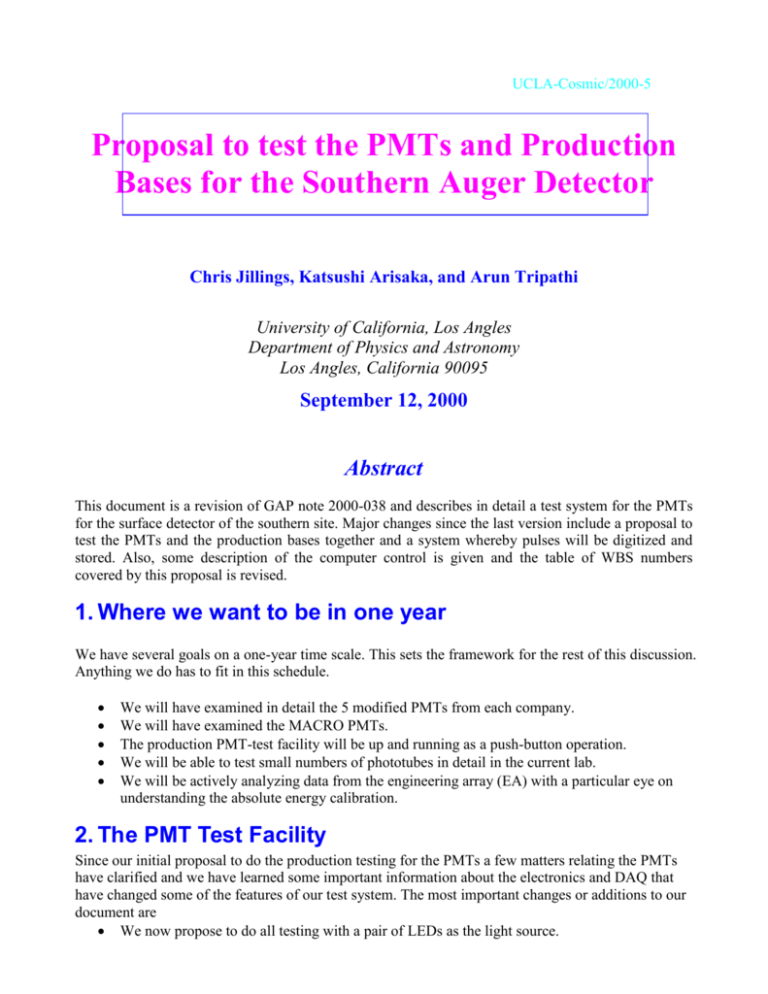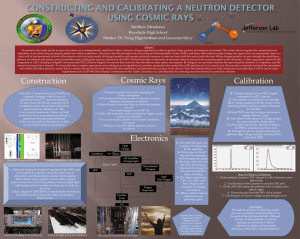MS Word - UCLA Physics & Astronomy
advertisement

UCLA-Cosmic/2000-5 Proposal to test the PMTs and Production Bases for the Southern Auger Detector Chris Jillings, Katsushi Arisaka, and Arun Tripathi University of California, Los Angles Department of Physics and Astronomy Los Angles, California 90095 September 12, 2000 Abstract This document is a revision of GAP note 2000-038 and describes in detail a test system for the PMTs for the surface detector of the southern site. Major changes since the last version include a proposal to test the PMTs and the production bases together and a system whereby pulses will be digitized and stored. Also, some description of the computer control is given and the table of WBS numbers covered by this proposal is revised. 1. Where we want to be in one year We have several goals on a one-year time scale. This sets the framework for the rest of this discussion. Anything we do has to fit in this schedule. We will have examined in detail the 5 modified PMTs from each company. We will have examined the MACRO PMTs. The production PMT-test facility will be up and running as a push-button operation. We will be able to test small numbers of phototubes in detail in the current lab. We will be actively analyzing data from the engineering array (EA) with a particular eye on understanding the absolute energy calibration. 2. The PMT Test Facility Since our initial proposal to do the production testing for the PMTs a few matters relating the PMTs have clarified and we have learned some important information about the electronics and DAQ that have changed some of the features of our test system. The most important changes or additions to our document are We now propose to do all testing with a pair of LEDs as the light source. We describe in detail the logic of driving the light source. We will not collect timing resolution information for every PMT. We will acquire a series of digitizations of the PMT pulses. We propose to use the production bases for the PMTs and test both the anode and dynode signal. We now assume an operating gain of 2105. A schematic of the PMT test system is shown in figure 1. Note that in this figure the PMTs are subdivided into groups of 12. This requires making more light sources but it does not require duplicating the logic and control because the same circuit can trigger all 4 light sources. Figure 1: A sketch of the production PMT test system. A schematic of our proposed test system is shown in figure 2. 2 Figure 2: A schematic of the proposed test system computer control and electronics. 3. Some Notes About the Light Source Using LEDs Two factors have convinced us that an LED pulsing circuit similar to the one used in the GAP note describing the detailed tests of the PMTs under consideration for use in the Auger ground array is the best for use in production testing. First, the on-site system in the tanks will have a 20 MHz bandwidth limit and sample at 40 MHz or every 25 ns. Thus timing on a scale smaller than this is irrelevant for the Auger detector. For all purposes other than timing – testing linearity over a wide dynamic range, estimating the gain using Poisson statistics and studying afterpulsing – the LED system is superior to or as good as any other system. Advantages of the LED system includes stability to better than 0.5% over several hours operation, low cost, and very importantly, minimal maintenance. Because blue is in the range of wavelengths at which we will detect most of the Cherenkov light, we will use a blue LED. At UCLA we use a light source composed of two LEDs. The light source flashes in a pattern of one LED (A), then the second LED (B), then both (A&B). This allows a direct measure of the linearity of the system because in a linear system the signal out for both LEDs is the sum of the signals from individual LEDs firing. In our current system we adjust the intensity of the light with an optical filter wheel with a continuously varying attenuation. For the production system we will control the light output with the driving voltage for the LED. 3 We have experience with a simple and reliable LED driving circuit. This circuit requires positive and negative power supply, a reference voltage to control the current through the LED and thus its brightness, and a TTL trigger signal to trip the transistor switch. We will automate this using a commercial PCI card (National Instruments 6025E). The A-B-A&B pattern will be generated using adjacent bits on the cards counter/timer. There are two analog output lines to control the brightness of the A and B LEDs. There are some digital output lines will be used to turn the source off and on and perhaps to control the speed. 4. Some Notes About the Base and High Voltage If we have production bases available for the PMT testing then the high voltage for the PMTs will be supplied on the base itself. The system must be able to supply 48 independent reference voltages. This functionality is available in commercial PCI cards. For example, the National Instruments 6700 series of PCI cards supplies 32 analog outputs with sufficient accuracy to control the high voltage. Two of these cards would be needed. Each of these cards supplies 8 bits of digital IO. The cost of these cards is 1100USD each. The base is useful as well for PMT testing because it amplifies the dynode signal. We therefore will be able to test the full dynamic range of the PMTs required for the Auger detectors without amplification and will be able to compare the anode and dynode signals. If the production bases are not available, then we require 48 channels of independently controlled high voltage. Such systems do exist and are commonly used in high-energy physics. One example is the CAEN SY series of high-voltage supplies. Sixty-four channel systems are available in a single crate. 5. Digitizing Individual Pulses for each PMT In lieu of testing the timing resolution of the PMTs we will digitize individual pulses for each PMT to ensure the pulse shapes are reasonable. This test is much more applicable to the Auger detector than a timing resolution test. Our digitization will be performed with either a digital scope connected to the computer with a GPIB bus or a PCI card with a digitizer. This decision has not yet been made and this will be the last hardware in the system to be built. Recording anode and dynode pulses will require a multiplexer or MUX. There is a CAMAC module made by Philips Scientific which multiplexes 8 inputs to 1 output. For 48 channels we would require 6 units and 6 channels of digitization or 7 units and one channel of digitization by feeding the output of the first 6 MUXes into the input of the 7th. To digitize both the anode and dynode would require the number of MUXes to be doubled. 6. The Testing Procedure The test procedure would begin with the selection of the PMTs to be tested. A base will be soldered to the PMT. The serial number of the base, the PMT, and the PMT data from the manufacturer will be entered into the computer. Included in the data from the manufacturer will be the suggested operating voltage for 2105 gain. 4 The PMTs will be placed in the darkroom and connected. The locations of the PMTs will be recorded on computer. This will allow the computer to know which PMT and base serial numbers are associated with which electronics channel. The operator will ensure the light seal is properly made in the test room and then will start the automated testing process. The PMTs will be slowly brought up to the manufacturers suggested voltage for a 2105 gain. Scalars will measure the dark count rate from the dynode signal (amplified such that the discriminator threshold can be set a t a fraction of a pe) to look for badly unstable PMTs. If such a PMT is found then its high voltage will be set to zero for the entire testing cycle. To look for the noise rate as a function of time (“cool down”), the PMTs will be brought up to the voltage at which the manufacturer suggests the PMT will have a gain of 106. Again, the dynode signal will be amplified and discriminated and scalars will read the singles rates. This process will take approximately 2 hours. For each PMT a Root Macro will be automatically generated which will produce a cool-down curve for on-screen display and printing. The cool-down curves will be available on screen as the data is being taken. After the cool-down test, the PMT voltage will be lowered slowly and the noise rate as a function of voltage will be measured. Note that the discriminator voltage will not change so the noise rate will appear to drop faster than it really is. It will be almost impossible to measure the spe noise rate at the operating gain. We will have measured for a gain of 106 or slightly higher, however. If a PMT has a marginal noise rate problem at 106, it will have to be studied individually for DC dark current. (This will require that the base be removed.) The gain will be measured as a function of voltage. The LED pulse will be fired to obtain a total charge histogram of the anode and dynode. This will be done with a bright light source but still within the linear region of the PMTs. This will allow the gain to measure at three intensities (A, B, and A&B) and this will offer a double check of the measurements. (While one may argue that there is no compelling reason to do this, there is also no compelling reason not to as the logic to test fire the pair of LEDs must exist for the linearity measurement.) The gain-vs-voltage will be stored and a Root macro to generate the gain-vs-voltage plot will be written. The linearity testing will then begin. The light intensity will be set by the computer and the pulse shapes will be measured by the digitizer. Because of the multiplexing required and the finite rate at which the digital scope will be able take data, the number of pulse samples for each PMT will be small. But this will suffice to measure the peak current for the case of LEDs A&B firing. After a sufficient number of events have been collected, the linearity at that peak current will be determined. The histograms will be archived and Root macros to produce plots will be generated. The linearity testing will require a wide range of light intensities. The system will first measure the linearity at a peak current slightly higher than the design specification and the driving voltage on the LED will then slowly be lowered to reduce intensity. Approximately 10 data points will be taken. A linearity as a function of peak cathode current will be archived. Once gain, a root macro will be generated to create plots. For the afterpulsing data the light source will be run and charge spectra accumulated as before but in this case the charge-sensitive ADC will be gated with a window between 200 ns and 5 s after the prompt peak. 5 After the data for the testing cycle has been collected, all the archived data will be stored in a directory whose name is defined by the PMT serial number and base serial number. If a PMT/base pair is tested twice, a second directory for that pair will be created. The PMT/base pair will be added to an html master index file. An html summary page will be generated for each pmt/base pair. The root macros for that PMT will be called to generate gif images for the html reports and PostScript for high-quality output. A latex file will be generated to have a high-quality report for printing. At the end of testing a summary file will be produced describing which PMTs passed, which failed and if known a possible cause of failure (PMT or base). The operator will then deal with the PMTs appropriately. Many PMT parameters are intimately linked. The most straight-forward way to disentangle them is to include several standard PMTs in the testing so that PMT can be compared to 7. The Computer Code We will write custom C++ code to control and automate the testing. We will as much as possible use existing codes including CAMAC control code used in a test stand by the UCLA “End Cap Muon” group in the CDF experiment. We will use the Root system for data archiving and display and supply Root macros to the collaboration. The PCI cards ship with libraries to control their low-level IO. Nonetheless, the coding effort will be large. Object-oriented programming is ideal for this task. Within our group there is experience in automated C++ control and measurement systems. A series of class hierarchies will be developed. At the lowest level will be classes that control the functions of the PCI cards. At a higher level of abstraction there will be classes to control electronics modules, for example the CAMAC crate controller. This code is still very much in the design stage but the following hierarchy is considered for controlling the light source: 1. At the lowest level are two classes: the CounterTimer class and a DCAnalogOutput class. 2. At a higher level of abstraction is the LightSourceIntensity, which knows the calibration constants between the analog output’s voltage and the voltage applied to the driving circuit. This class would contain the allowed voltage range and would have a human interface. For example, this class allows the light source to be set at 80% intensity. Of course, this class must use the DCAnalogOutput class to achieve this. 3. Analogous to the LightSourceIntensity class is the LightSourceRate class, which chooses which bits on the counter/timer trigger the light source. This class will also have an Off() and On() function to turn the light source off and on. 4. At the highest level would is the LightSource which will be derived from the LightSourceIntensity and LightSourceRate classes. This hierarchy allows the main control program to call simple functions like On(), Intensity(0.8), and Rate(“fast”). This type of hierarchy uses the best features of C++, notably inheritance and data hiding. If the hardware is changed for whatever reason, the only code that needs to be changed is the function in the lowest-level classes. The high-level code is unchanged. The over-arching system to control the system will be class which contains a list of high-level hardware objects. This class will have a method which polls the hardware in turn taking appropriate action. 6 8. What We Need To Do When There are several tasks ahead for the UCLA group. For practical and scheduling reasons, work will begin with the light source. The PC card for the light source will be ordered by November 1, 2000. The detailed design of the electronics to interface between the card and the chips will be designed and a prototype light source will be built starting immediately after the November 2000 collaboration meeting. When the prototype light source is ready will test it to measure the angular distribution of light and the brightness. From this we will determine the number of sources required. Note that there is no real reason to limit the number of sources other than the fanout of the triggering logic may be somewhat more complicated. If required, we could have one light source for every four PMTs. As soon as possible we will acquire the required CAMA hardware and start intensive development of the CAMAC codes. We would like to get a working two-channel system in place before construction of the dark room begins in mid January. When that construction begins we will be able to start doing development work at the Science and Technology Research Building (STRB) at UCLA. Choose a computer and operating system. Linux is preferable for many reasons, but the PCI cards may not have drivers in Linux. If not we will have to use W98 or NT/2000. Light source 1. Design a circuit to interface between the PCI card (National Instruments 6025E) and the light source. This circuit is responsible for controlling A, B, A&B cycle of the light source and the intensity of the light source. 2. Build a prototype LED driver following our existing circuit. 3. Decide on method to supply DC voltage to the light source. 4. Write the code to control this card. CAMAC/NIM: We require the following components: 1. 15 Phillips Scientific Octal Linear Gate Multiplexers. (14 for the signal lines and one to select the gate for the prompt peak or the afterpulsing.) 2. 96 channels + spares of ADC channels capable of accepting a gate of 5 s width. 3. Kinetic Systems XXXX Crate controller and PCI card. 4. Write the CAMAC code/adapt the code currently in the FAST site. Digitizer: We need to choose a digitizer and write the code to use it. Database and data logging 1. We need to build a simple ASCII database containing the data for the PMTs in the test 2. Build database and code to read to associate a given ADC channel/multiplexer input with a given testing location and PMT. 3. Write the control code for the system. 9. WBS Tables This table is modeled after the table in our first report and but is changed slightly to reflect the changes described above. As well it is changed to reflect the fact that we now propose to test the PMT, the base and the assembly of the two. This adds significantly to the human resources effort required for the testing and also requires that we build an assembly stand. 7 The TDCs are included although we do not plan on including them in the test system initially. TDC information is useful for understanding the cause of high rates of afterpulsing. WBS Purpose Description 2.2.1.2.3 2.2.1.2.3 2.2.1.2.3 2.2.1.2.3 2.2.1.2.3 2.2.1.2.3 2.2.1.2.3 Elec: Afterpulsing Elec: Dark noise Elec: Dark Noise Elec: Gain/linearity Elec: Pulse shape Elec: misc Elec: Hardware TDC with 10 s full scale Leading-Edge Discriminator CAMAC scalar Charge-sensitive ADC (with 5 s gate) CAMAC Octal MUX Quad Gate/delay generator (Phillips NIM 794) 1 rack, CAMAC Crate, NIM bin 2.2.1.2.3 2.2.1.2.3 2.2.1.1.2 2.2.1.2.3 2.2.1.2.3 DAQ DAQ DAQ DAQ DAQ Computer CAMAC Crate Controller PCI card for light source (Nat. Inst. 6025E) PCI card for HV control (Nat. Inst. 6704) PCI card for waveform digitization 2.2.1.2.3 2.2.1.2.3 2.2.1.2.3 2.2.1.2.3 Cables Cables Cables Cables 2.2.1.2.3 2.2.1.2.3 2.2.1.2.3 2.2.1.2.3 2.2.1.2.3 2.2.1.2.3 2.2.1.2.3 Cables Cables Cables Cables Cables Cables Cables 50 signal cable RG-58 (1000-foot roll) Connectors at base BNC connectors Patch panel connectors (1 BNC, 4 LEMO bulkhead) Patch panel to MUX: length = 4 ns Patch panel to ADCs: length = 4 ns Patch panel to Amp: length = 4ns Amp to Disc: length = 4ns Discriminators to TDCs: length = 4 ns Discriminators to Scalars: length = 4 ns Ribbon cables for light source and connectors 2.2.1.2.3 2.2.1.2.3 Light source Light Source 2.2.1.2.3 2.2.1.2.3 Light Source Light source Development and testing PCI to light source interface (custom electronics) Purchase of parts for LED circuits Machining and construction 2.2.1.2.3 2.2.1.2.3 Dark room Dark room Construction Hardware for dark room development. 2.2.2.1.4.2 2.2.2.1.4.2 Base Base Base Build assembly jig Equipment for assembly Material for potting base after mounting on PMT 2.2.1.2.2.6 Human Resources 2.2.2.2.2.5 Human Resources MACRO PMTs Testing of PMTs and maintenance of test stand based on estimated cost per PMT Assembly of base on PMT HR required to adapt MACRO PMTs for Auger No. Cost/ Unit 48+ chan 48+ chan 48+ chan 96+ chan 15 1 1 1 1 1 2 2 Sub 2 100 100 50 100 100 50 50 50 50 Sub 1 3500 2500 700 1100 3500 Total 150 10 5 25 3500 2500 700 2200 7000 15,000 300 1000 500 1250 10 10 10 10 10 10 1000 1000 500 500 500 500 500 5750 2000 2000 Total 2000 Sub Total Sub Total Sub 5000 Total 5000 Total Grand Total 8 Cost (USD) 5000 1000 10,000 8,000 2,000 10,000 500 2000 ? 10,000 90,000 90,000 60,000 240,000 290,750 There are a couple of points to be made relating to this table. First, in the list of CAMAC items we have listed some TDCs that aren’t included in the test schematic. We have found that TDCs are useful in understanding the source of afterpulsing. We would prefer not to put TDCs in the production system and uses them only for smaller samples of PMTs chosen for detailed testing. However, it may be necessary to include them in production testing. Second, no prices are listed for CAMAC-related items. As indicated in the previous version of this document, we hope to be able to be able to borrow these items from FNAL. 10. Conclusions We have a design for a PMT testing system that will meet the Auger requirements. We will start construction as soon as possible. We will be gin by designing the computer-control system for the light source. Construction of the dark rooms will begin in January 2001. We will have the system operational in the spring of 2001 to start work on the testing of the MACRO PMTs. We will continue development over the summer to turn the system into a push-button operation. 9







